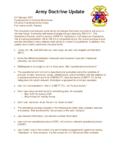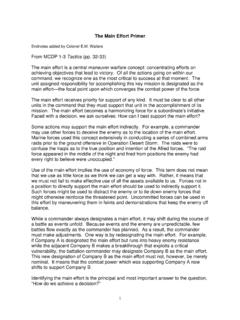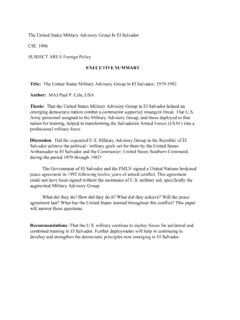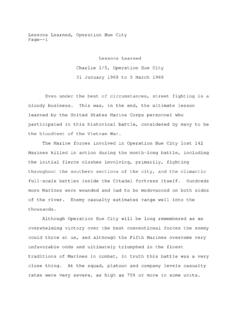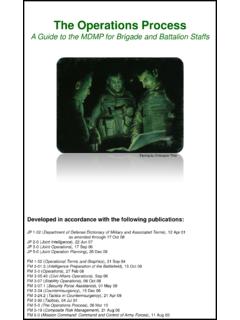Transcription of DEPARTMENT OF MILITARY STRATEGY, …
1 DEPARTMENT OF MILITARY strategy , planning , AND operations Army War College CAMPAIGN planning PRIMER AY 04 TABLE OF CONTENTS Introduction .. 1 Campaign planning , JOPES, and JSPS .. 3 Deliberate planning Process .. 4 Crisis Action planning (CAP) Process.. 4 Campaign planning Process .. 5 Theater planning Actions .. 6 Strategic Guidance.. 7 Commander s Estimate.. 7 Derive the Mission.. 8 Endstate.. 10 Commander s Intent.. 11 Situation Analysis.. 12 Geostrategic Factors .. 12 Identify Limiting Factors.. 13 Identify planning Assumptions.
2 13 COGs, Vulnerabilities, and Decisive Points .. 14 Assess Enemy Capabilities.. 17 Develop Enemy Capabilities .. 18 Prioritize ECs and Select One as Baseline.. 19 Intelligence Considerations.. 19 Commander s planning Guidance.. 20 Course of Action Development .. 21 COA Development Considerations .. 23 Course of Action Analysis.. 24 COA Analysis Considerations.. 25 COA Comparison .. 26 COA Recommendation .. 26 Strategic Concept .. 27 Objectives and Subordinate Tasks.
3 28 Joint Force Organization.. 29 Service Components .. 30 Functional Components.. 31 Subordinate Joint Commands .. 32 Combined Force Organization .. 33 Parallel Command Structures.. 33 Lead Nation Command Structures .. 34 Combination Command Structures .. 35 Considerations .. 36 Requirements for Supporting Plans .. 37 Considerations .. 38 Flexible Campaign Plan.. 38 Staff Responsibilities for planning .. 39 Summary of theater Campaign planning .. 41 Introduction Campaign planning has been a technique used by famous commanders to synchronize efforts and to sequence several related operations .
4 George Washington planned his campaign of 1781 to coordinate the actions of the French Fleet with his Franco-American land army to destroy the British forces at Yorktown. General U. S. Grant planned simultaneous offensives by Generals Sherman and Meade among others against the Confederacy as his plan for the 1864 campaign. During World War II, campaign planning became essential to coordinate the actions of joint and combined forces in all Allied theaters. As a mature example of campaign planning in the later stages of World War II in the Pacific Theater of War, General Douglas MacArthur issued his Strategic Plan for operations in the Japanese Archipelago (DOWNFALL) in May 1945.
5 In this twenty-five page document, MacArthur describes how This Plan of campaign visualizes attainment of the assigned objectives by two (2) successive operations (OLYMPIC and CORONET). The cover letter describes this plan as a general guide covering the larger phases of allocation of means and of coordination, both operational and logistic. It is not designed to restrict executing agencies in detailed development of their final plans of operation. Unfortunately, during the 1960s and 1970s, campaign planning became virtually replaced at the theater level by the DOD-directed, computer-supported Joint operations planning System (JOPS) which emphasized deployment planning .
6 Campaign planning received new emphasis after Operation DESERT STORM in which General Norman Schwartzkopf used a campaign plan to guide the synchronized employment of his forces. A campaign plan embodies the theater combatant commander s strategic vision of the arrangement of operations needed to attain the strategic objectives assigned by higher authority. It orients on the enemy s centers of gravity; achieves unity of effort with unified action (joint, combined or coalition, and interagency); clearly defines what constitutes success; and serves as the basis for subordinate planning .
7 Campaign plans are the operational extension of a combatant commander s theater strategy . They translate strategic concepts into unified plans for MILITARY action by specifying how operations , logistics, and time will be used to attain theater strategic objectives. Through theater campaign plans, combatant commanders define objectives, describe concepts of operations , sequence operations , organize forces, establish command relationships, assign tasks, and synchronize air, 1 land, sea, and space operations and their sustainment. Campaign planning is a primary means by which combatant commanders arrange for strategic unity of effort and through which they guide the planning of joint operations within their theater of operations .
8 A campaign plan communicates the commander s intent, requirements, objectives, and concept to subordinate components and joint forces, as well as to parent Services so that they may make necessary preparations. In addition, by means of a campaign plan, combatant commanders give the President, Secretary of Defense (SECDEF), and the Chairman of the Joint Chiefs of Staff (CJCS) information needed for inter-theater coordination at the national level. Campaigns are conducted in a theater of war: total land, sea, and air space. They may be along more than one line of operation. Theater campaigns synthesize deployment, employment, sustainment, and supporting operations into a coherent whole.
9 Theater campaigns are planned before hostilities and guide execution during them. A theater campaign may consist of a sequence of related unified operations designed to achieve the combatant commander s objectives (Figure 1). A single campaign is a phased series of major operations . More than one campaign may be required to accomplish a strategic objective. PHASEI1 STOPN2 NDOPN3 RDOPN4 THOPND eter/EngageSeizeInitiativeDecisiveOperat ionsTransitionEndStatePHASEIIPHASEIIIPHA SEIV FIGURE 1: Graphic Depiction of a Campaign Plan 2 Campaign planning , JOPES and JSPS As stated in Joint Pub 5-0, Doctrine for planning Joint operations , Campaign planning can begin before or during deliberate planning but is not completed until crisis action planning , thus unifying both planning processes.
10 A campaign plan is finalized during crisis or conflict once the actual threat, national guidance, and available resources become evident. However, the basis and framework for successful campaigns are laid by peacetime analysis, planning , exercises, and application of campaign planning principles (Figure 2). JOINT OPERATION PLANNINGD eliberatePlanningCrisis ActionPlanningOPLANw/o TPFDDCONPLANw/TPFDDF unctionalPlanOPORDC ampaignPlanOPORDOPLANTSCPC ampaign PlanningPrinciples FIGURE 2: Joint operations planning For example, in the spring of 1990, Central Command (CENTCOM) reevaluated its OPLANS for the Persian Gulf region in light of new regional strategic and MILITARY situations.

